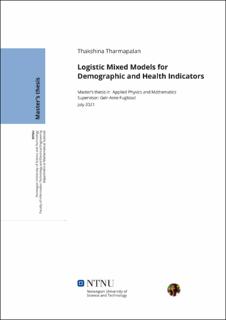Logistic Mixed Models for Demographic and Health Indicators
| dc.contributor.advisor | Fuglstad, Geir-Arne | |
| dc.contributor.author | Tharmapalan, Thakshina | |
| dc.date.accessioned | 2021-11-13T18:19:31Z | |
| dc.date.available | 2021-11-13T18:19:31Z | |
| dc.date.issued | 2021 | |
| dc.identifier | no.ntnu:inspera:75366163:32755812 | |
| dc.identifier.uri | https://hdl.handle.net/11250/2829445 | |
| dc.description.abstract | Nyfødtdødelighet og vaksinedekning mot meslinger er viktige helseindikatorer for en nasjon. Demographic and Health Surveys (DHS) er en pålitelig kilde for å spore indikatorer for å forbedre en nasjons helse i lav- og mellominntektsland. DHS dataene blir transformert til et standardisert format med samme struktur på tvers av land. Det standardiserte formatet gjør det mulig å sammenligne estimater på tvers av undersøkelser og land. Prøver fra en populasjon gjennom undersøkelser er ofte samlet på en tids- og kostnadseffektiv måte. Undersøkelsedesign er typisk kompleks fordi det generelt inkluderer ulike inkluderingssannsynligheter for observasjoner i befolkningen, stratifisert prøvetaking og klyngesampling. DHS data er basert på stratifisert flertrinnssampling. Blandede modeller til estimering tar vanligvis ikke hensyn til disse designfunksjonene. Imidlertid brukes ustrukturerte klyngespesifikke tilfeldige effekter generelt for å anerkjenne klyngingen. Dette justerer den tilsynelatende prøvestørrelsen for korrelasjonen innen klyngen. I denne masteroppgaven anvendes blandede modeller for å estimere nyfødtdødelighet og vaksinasjonsdekning mot mesling av første dose blant 1-åringer på DHS data samlet i Nigeria og Kenya. Denne studien fokuserer på modellestimater på nasjonalt nivå, og justerer for forklarende variabler som mors alder, urbant- eller landlig bosted, og klyngeeffekt. Aldersgrupper for mødre er innlemmet i modellen som strukturerte og ustrukturerte tilfeldige effekter for å evaluere evnen til å låne styrker fra grupper og for å redusere avviket i estimatene. De forklarende og prediktive styrkene til de utviklede modellene undersøkes. Modellene er estimert ved hjelp av den integrerte nestede Laplace-tilnærmingen (INLA) med pakken R-INLA i R. Metodene blir evaluert ved hjelp av et sett av mål i et simuleringsstudie og på reelle undersøkelsesdata. Denne analysen konkluderer med at blandede modeller brukt på DHS data klarer innlemme for klynging for små klyngeeffekter. Ustrukturerte og strukturerte tilfeldige effekter bidrar til å begrense variasjon i estimater mellom mors aldersgrupper. Blandede modeller bør imidlertid revurderes når de brukes på komplekse undersøkelsesdata fordi de ikke tar hensyn til viktige aspekter som inkluderingssannsynligheter. | |
| dc.description.abstract | Neonatal mortality rate and vaccination coverage of measles-containing vaccine are important health indicators of a nation. The Demographic and Health Surveys (DHS) program is one major source for tracking health indicators to identify the need for interventions in low- and middle-income countries. The DHS data is transformed to a standardized format with the same structure across countries. The standardized format facilitates comparisons across surveys and countries. Samples in surveys are often collected from a population in a way that is time- and cost-effective. A complex design generally includes unequal inclusion probabilities of the units in the population, stratified sampling, and cluster sampling. DHS data is based on stratified multistage sampling. Mixed models to estimation do not typically account for these design features. However, a common way to acknowledge clustering is to include unstructured cluster-specific random effects. This adjusts the apparent sample size for the intra-cluster correlation. The main goal of this thesis is to make inferences about estimates of neonatal mortality rate and coverage of first dose measles-containing vaccine among 1-year-olds using logistic mixed models on DHS data collected in Nigeria and Kenya. This study focuses on model estimates at the national level adjusting for explanatory variables such as maternal age, urban or rural residency, and cluster effects. The maternal age groups are incorporated as unstructured and structured random effects to evaluate the ability to borrow strengths from groups to improve the estimates, in addition, to reduce the variance in the estimates. The explanatory and predictive strengths of the models are investigated, and inference is conducted using the integrated nested Laplace approximation (INLA) with the package R-INLA in R. The methods are evaluated on a set of scoring rules through a simulation study and on real survey data. This analysis concludes that mixed effects models applied on DHS data manage to incorporate clustering for small cluster effects. Unstructured and structured random effects succeed to limit variation in estimates between maternal age groups. The uncertainty in the estimates of the outermost age groups, which consist of only a small amount of data, is reduced. Mixed models should, however, be reconsidered when it is applied to complex survey data because they fail to correctly account for important aspects of survey methodology such as sampling weights. | |
| dc.language | eng | |
| dc.publisher | NTNU | |
| dc.title | Logistic Mixed Models for Demographic and Health Indicators | |
| dc.type | Master thesis |
